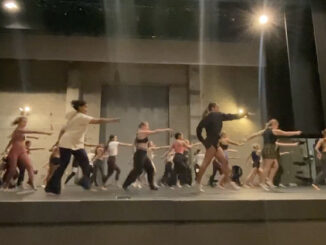
Prep. Pose. Perfect.
Those are the three Ps that student TikTok creators at Pepperdine are all familiar with when it comes to producing engaging content, especially about their boujee university lifestyle.
On a campus that has been ranked No. 2 on California College Prep’s Top 10 Most Beautiful College Campuses in California, it is no surprise that Pepperdine’s rolling landscapes and bird’s eye view of the Pacific Ocean attracts thousands of prospective students every year through social media avenues such as TikTok.
“The content I see from current students makes me want to go there because it looks so fun to be near the beach all day,” said Piper Ryan, a junior at St. Mary’s High School in Stockton, California, who is currently in the process of searching for universities to apply to this upcoming fall. “I would definitely be there in between or after classes.”
However, what Ryan may not know is that TikTok creators are adding filters to the content they post. Unlike the fun filters that alter appearances, these filters glamorize the realities of student life, specifically day-in-the-life videos at Pepperdine.
Preference for time-limited videos
Last year, TikTok had a 45% growth increase with 1 billion active users since its last report of 689 million in July 2020, according to Statista. It is also ranked the sixth most popular social networking site worldwide.
A Pepperdine Graphic poll of 63 students conducted in March 2021 found that 60% of students said it was the social media platform they use the most. The poll found that more students favored a time limit on their videos compared to those who disliked the feature.
Ann Abramain, a junior integrated marketing communication major, said she is one of those students who favor the time limit.
“Obviously I’m not going to broadcast anything that’s tough or hard like that’s happening in my life on social media,” Abramian said. “So I’m only taking nice snippets of my day to post and make an aesthetically pleasing video.”
Although Abramain doesn’t make content about the university, she does make videos that highlight her life living in sunny Malibu.
TikTok snippets reject the traditional long videos of the past, and instead present simple and interesting features to the audience, Shaui Yang and co-authors wrote in a 2019 International Conference on Information and Social Science publication.
Traditional videos would include character, conflict, theme and setting. In short videos, certain elements like conflict can get ignored and alter storytelling organization, Yang wrote.
“Putting in work as students obviously doesn’t show because it probably looks like we are on vacation,” Abramain said.
Shooting a perfect day in the life at Pepperdine
Olivia Formato, a first-year education major and Pepperdine day-in-the-life content creator, said she is motivated to capture things that are most appealing to the eye.
“When I make my bed in the morning it will be the perfect color scheme and when I walk outside Crocker I’ll capture the perfect view of the ocean and the big palm trees on main,” Formato said.
Formato began her career as a TikTok creator as a high school student in Norway because it offered her an outlet to express her personality and give an inclusive peek into her life. Formato said she grew her account when attending Pepperdine and she now has a following of 2,661.
“There are some points when I’m flexing the view a little bit because I’m like this will make people be like the Zoey 101 school,” Formato said.
Like most content creators, Formato formulates her content so that it showcases the parts of her life that will increase engagement. Formato said the beach is definitely an element she incorporates when making her videos. In a recent day-in-the-life video, she included an encouraging message to her followers while she documents her daily activities.
Behind the filter
Senior communication major Michela Harris makes content to display her fashion expertise. Harris said she enjoys the app but notices that creators like herself will often make videos and
not realize the severe impacts on mental health. The two most popular effects of social media as anxiety and depression, according to the The National Library of Medicine.
“The obvious fact is that most people do suffer from the false realities of social media,” Harris said.
Despite the negative impacts that come with filtered media, Harris said woke creators have begun to use their platforms to bring light to real-life issues.
“There are some content creators that do talk about real topics like mental health or eating disorders and things that are actually real versus having a perfect life or perfect clothes 24/7,” Harris said. “That’s not real.”
Public Relations Professor Komal Kapoor believes that content is created based on what audiences want. However, she said it is possible to teach a target audience to look at both bad and happy moments to promote a realistic narrative. Kapoor practices this with her own audience on social media.
“If I had a horrible day I may have a candle lit up and I write a couple lines saying not everyday can be perfect because my audience is willing to listen to that,” Kapoor said. “I think that’s what creators need to do as well.”
Although Kapoor does not make TikTok content, she creates content for her audience on Instagram and Facebook. She said her generation on Facebook is also very selective in what is posted.
“If you want to maintain a personality or identity of some sort, definitely be more careful of what you’re posting,” Kapoor said.
She recommends that creators take into account who their audiences are and if they would respond positively to either filtered versions of content or realistic cuts.
Pepperdine’s TikTok and steps for authentic representation

First-year IMC major Liam Zieg created video content for Pepperdine’s official page last fall. Zieg said he loves that he can walk from his first-year hall to class and see at least one other student that he knows.
“I videotaped people on the way to class, me waving to them, people in class and my relationships with them,” Zieg said. “I feel like that was very accurate to what Pepperdine is.”
Zieg said his experience in the content creator position for the university made him focus on portraying the value of community.
Despite Zieg’s efforts, there is still concern that the university is not accurately showing the realities of student life.
“Post the reality, not just what people see online,” junior biology major Alayna Weyandt wrote on Pepperdine’s most recent TikTok from Jan. 30.
Weyandt did not respond to requests for comment. The comment has since been deleted.
As of March 21, the Pepperdine account has a following of 3,894 and only two recorded posts in 2022. The account previously shared six to eight videos per month.
Tamara O’Brien, IMC’s interim director of operations, said the social media manager position is currently open after Laura Nickerson left to become head of social media at Keck School of Medicine at the University of Southern California.
Liberty Gascon-Galindo reported this enterprise story in Jour 241 during the Spring 2022 semester under the supervision of Dr. Christina Littlefield and Dr. Theresa de los Santos. Dr. Littlefield supervised the web article.




